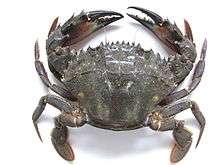Glaessneropsoidea
Glaessneropsoidea is a superfamily of fossil crabs.[1] They are found in rocks from Late Jurassic age to Late Cretaceous.[2] The 45 species in the superfamily are divided among 11 genera in four families:[1]
- Family Glaessneropsidae Patrulius, 1959
- Ekalakia Bishop, 1976
- Glaessneropsis Patrulius, 1959
- Rathbunopon Stenzel, 1945
- Vectis Withers, 1946
- Verrucarcinus Schweitzer & Feldmann, 2009
- Family Lecythocaridae Schweitzer & Feldmann, 2009
- Lecythocaris von Meyer, 1860
- Family Longodromitidae Schweitzer & Feldmann, 2009
- Abyssophthalmus Schweitzer & Feldmann, 2009
- Coelopus Étallon, 1861
- Longodromites Patrulius, 1959
- Planoprosopon Schweitzer, Feldmann & Lazǎr, 2007
- Family Nodoprosopidae Schweitzer & Feldmann, 2009
- Nodoprosopon Beurlen, 1928
| Glaessneropsoidea | |
|---|---|
| Scientific classification | |
| Kingdom: | |
| Phylum: | |
| Subphylum: | |
| Class: | |
| Order: | |
| Infraorder: | |
| Section: | |
| Superfamily: | Glaessneropsoidea Patrulius, 1959 |
| Families | |
| |
References
- Sammy De Grave; N. Dean Pentcheff; Shane T. Ahyong; et al. (2009). "A classification of living and fossil genera of decapod crustaceans" (PDF). Raffles Bulletin of Zoology. Suppl. 21: 1–109. Archived from the original (PDF) on 2011-06-06.
- Rodney M. Feldmann; Carrie E. Schweitzer; William R. Wahl (2008). "Ekalakia (Decapoda: Brachyura): the preservation of eyes links Cretaceous crabs to Jurassic ancestors" (PDF). Journal of Paleontology. 82 (5): 1030–1034. doi:10.1666/08-006.1. Archived from the original (PDF) on 2012-07-26.
This article is issued from Wikipedia. The text is licensed under Creative Commons - Attribution - Sharealike. Additional terms may apply for the media files.
